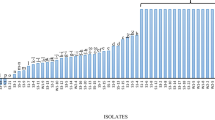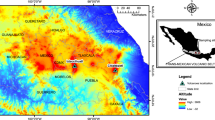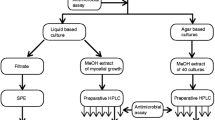Abstract
The insecticide chlordecone is a contaminant found in most of the banana plantations in the French West Indies. This study aims to search for fungal populations able to grow on it. An Andosol heavily contaminated with chlordecone, perfused for 1 year in a soil–charcoal system, was used to conduct enrichment cultures. A total of 103 fungal strains able to grow on chlordecone-mineral salt medium were isolated, purified, and deposited in the MIAE collection (Microorganismes d'Intérêt Agro-Environnemental, UMR Agroécologie, Institut National de la Recherche Agronomique, Dijon, France). Internal transcribed spacer sequencing revealed that all isolated strains belonged to the Ascomycota phylum and gathered in 11 genera: Metacordyceps, Cordyceps, Pochonia, Acremonium, Fusarium, Paecilomyces, Ophiocordyceps, Purpureocillium, Bionectria, Penicillium, and Aspergillus. Among predominant species, only one isolate, Fusarium oxysporum MIAE01197, was able to grow in a liquid culture medium that contained chlordecone as sole carbon source. Chlordecone increased F. oxysporum MIAE01197 growth rate, attesting for its tolerance to this organochlorine. Moreover, F. oxysporum MIAE01197 exhibited a higher EC50 value than the reference strain F. oxysporum MIAE00047. This further suggests its adaptation to chlordecone tolerance up to 29.2 mg l−1. Gas chromatography–mass spectrometry (GC-MS) analysis revealed that 40 % of chlordecone was dissipated in F. oxysporum MIAE01197 suspension culture. No chlordecone metabolite was detected by GC-MS. However, weak amount of 14CO2 evolved from 14C10-chlordecone and 14C10-metabolites were observed. Sorption of 14C10-chlordecone onto fungal biomass followed a linear relationship (r 2 = 0.99) suggesting that it may also account for chlordecone dissipation in F. oxysporum MIAE01197 culture.






Similar content being viewed by others
References
Abadulla E, Tzanov T, Costa S, Robra KH, Cavaco-Paulo A, Gubitz GM (2000) Decolorization and detoxification of textile dyes with a laccase from Trametes hirsuta. Appl Environ Microbiol 66(8):3357–3362
Aksu Z (2005) Application of biosorption for the removal of organic pollutants: a review. Process Biochem 40(3–4):997–1026
Alabouvette C (1986) Fusarium -wilt suppressive soils from the Châteaurenard region: review of a 10-year study. Agronomie 6(3):273–284
Anderson IC, Cairney JWG (2004) Diversity and ecology of soil fungal communities: increased understanding through the application of molecular techniques. Environ Microbiol 6(8):769–779
Benoit P, Barriuso E, Calvet R (1998) Biosorption characterization of herbicides, 2,4-D and atrazine, and two chlorophenols on fungal mycelium. Chemosphere 37(7):1271–1282
Bhalerao TS, Puranik PR (2007) Biodegradation of organochlorine pesticide, endosulfan, by a fungal soil isolate, Aspergillus niger. Int Biodeterior Biodegrad 59(4):315–321
Bridge P, Spooner B (2001) Soil fungi: diversity and detection. Plant Soil 232:147–154
Cabidoche YM, Achard R, Cattan P, Clermont-Dauphin C, Massat F, Sansoulet J (2009) Long-term pollution by chlordecone of tropical volcanic soils in the French West Indies: a simple leaching model accounts for current residue. Environ Pollut 157(5):1697–1705
Cabidoche YM, Lesueur-Jannoyer M (2012) Contamination of harvested organs in root crops grown on chlordecone-polluted soils. Pedosphere 22(4):562–571
Caira M, Posteraro B, Sanguinetti M, de Carolis E, Leone G, Pagano L (2012) First case of breakthrough pneumonia due to Aspergillus nomius in a patient with acute myeloid leukemia. Med Mycol 50(7):746–750
Clostre F, Lesueur-Jannoyer M (2012) Transfert de la chlordécone du sol vers les produits cultivés. Document de synthèse Cirad (in French).
Coat S, Bocquene G, Godard E (2006) Contamination of some aquatic species with the organochlorine pesticide chlordecone in Martinique. Aquat Living Resour 19(2):181–187
Coat S, Monti D, Legendre P, Bouchon C, Massat F, Lepoint G (2011) Organochlorine pollution in tropical rivers (Guadeloupe): role of ecological factors in food web bioaccumulation. Environ Pollut 159(6):1692–1701
Dallaire R, Muckle G, Rouget F, Kadhel P, Bataille H, Guldner L, Seurin S, Chajes V, Monfort C, Boucher O, Thome JP, Jacobson SW, Multigner L, Cordier S (2012) Cognitive, visual, and motor development of 7-month-old Guadeloupean infants exposed to chlordecone. Environ Res 118:79–85
Dolfing J, Novak I, Archelas A, Macarie H (2012) Gibbs free energy of formation of chlordecone and potential degradation products: implications for remediation strategies and environmental fate. Environ Sci Technol 46(15):8131–8139
Dorigo U, Leboulanger C, Berard A, Bouchez A, Humbert JF, Montuelle B (2007) Lotic biofilm community structure and pesticide tolerance along a contamination gradient in a vineyard area. Aquat Microb Ecol 50(1):91–102
Dritsa V, Rigas F, Natsis K, Marchant R (2007) Characterization of a fungal strain isolated from a polyphenol polluted site. Bioresour Technol 98(9):1741–1747
Edel V, Steinberg C, Gautheron N, Recorbet G, Alabouvette C (2001) Genetic diversity of Fusarium oxysporum populations isolated from different soils in France. FEMS Microbiol Ecol 36(1):61–71
Evans J, Levesque D, De Lahunta A, Jensen HE (2004) Intracranial fusariosis: a novel cause of fungal meningoencephalitis in a dog. Vet Pathol 41(5):510–514
FAO/ISRIC/ISSS (1998) World Reference Base for Soil Resources. World Soil Resources Report 84, FAO, Rome
Fernandes P, Lesueur-Jannoyer M, Soler A, Achard R, Woignier T Effects of clay microstructure and compost quality on chlordecone retention in volcanic tropical soils: consequences on pesticide lability and plant contamination. In: 19th World Congress of Soil Science, Soil Solutions for Changing World, Brisbane, Australia., 1–6 August 2010. pp 50–53
Gardes M, Bruns TD (1993) ITS primers with enhanced specificity for basidiomycetes—application to the identification of mycorrhizae and rusts. Mol Ecol 2(2):113–118
George SE, King LC, Claxton LD (1986) High-performance liquid-chromatography separation of chlordecone and its metabolites. Chromatographia 22(1–6):165–167
Gorman SR, Magiorakos AP, Zimmerman SK, Craven DE (2006) Fusarium oxysporum pneumonia in an immunocompetent host. S Med J 99(6):613–616
Hasan HAH (1999) Fungal utilization of organophosphate pesticides and their degradation by Aspergillus flavus and A. sydowii in soil. Folia Microbiol 44(1):77–84
Hedayati MT, Pasqualotto AC, Warn PA, Bowyer P, Denning DW (2007) Aspergillus flavus: human pathogen, allergen and mycotoxin producer. Microbiology 153(6):1677–1692
Jablonski PE, Pheasant DJ, Ferry JG (1996) Conversion of Kepone by Methanosarcina thermophila. FEMS Microbiol Lett 139(2–3):169–173
Johny S, Kyei-Poku G, Gauthier D, van Frankenhuyzen K (2012) Isolation and characterisation of Isaria farinosa and Purpureocillium lilacinum associated with emerald ash borer, Agrilus planipennis in Canada. Biocontrol Sci Technol 22(6):723–732
Juhasz AL, Smith E, Smith J, Naidu R (2002) Biosorption of organochlorine pesticides using fungal biomass. J Ind Microbiol Biotechnol 29(4):163–169
Kapoor A, Viraraghavan T (1995) Fungal biosorption—an alternative treatment option for heavy metal bearing wastewaters: a review. Bioresour Technol 53(3):195–206
Kilzer L, Scheunert I, Geyer H, Klien W, Korte F (1979) Laboratory screening of the volatilization rates of organic chemicals from water and soil. Chemosphere 10:751–761
Kim YH, Ahn JY, Moon SH, Lee J (2005) Biodegradation and detoxification of organophosphate insecticide, malathion by Fusarium oxysporum f. sp pisi cutinase. Chemosphere 60(10):1349–1355
Klich MA (2002) Biogeography of Aspergillus species in soil and litter. Mycologia 94(1):21–27
Kobayasi Y (1938) The genus Cordyceps and its allies. Science reports of the Tokyo Bunrika Daigaku 5
Kurtzman CP, Horn BW, Hesseltine CW (1987) Aspergillus nomius, a new aflatoxin-producing species related to Aspergillus flavus and Aspergillus tamarii. Antonie Van Leeuwenhoek 53(3):147–158
Lass-Flörl C, Griff K, Mayr A, Petzer A, Gastl G, Bonatti H, Freund M, Kropshofer G, Dierich MP, Nachbaur D (2005) Epidemiology and outcome of infections due to Aspergillus terreus: 10-year single centre experience. Br J Haematol 131(2):201–207
Le Déault JY, Procaccia C (2009) Les impacts de l'utilisation de la chlordécone et des pesticides aux Antilles: bilan et perspectives d'évolution. Report no. 1778 of French National Assembly (in French).
Li F, Huang SF, Liu B (2006) Degradation of phoxim by Paecilomyces lilacinus. Chin J Appl Environ Biol 12:104–107 (in Chinese with English abstract)
Lievremont D, SeigleMurandi F, BenoitGuyod JL, Steiman R (1996) Biotransformation and biosorption of pentachloronitrobenzene by fungal mycelia. Mycol Res 100:948–954
Manter DK, Vivanco JM (2007) Use of the ITS primers, ITS1F and ITS4, to characterize fungal abundance and diversity in mixed-template samples by qPCR and length heterogeneity analysis. J Microbiol Methods 71(1):7–14
Martin-Laurent F, Sahnoun M, Merlin C, Vollmer G, Lübke M (2013) Detection and quantification of chlordecone in contaminated soils from the French West Indies by GC-MS using 13C10-chlordecone stable isotope as a tracer. Env Sci Pollut Res. doi:10.1007/s11356-013-1839-y
Mukherjee I, Mittal A (2005) Bioremediation of endosulfan using Aspergillus terreus and Cladosporium oxysporum. Bull Environ Contam Toxicol 75(5):1034–1040
Multigner L, Ndong JR, Giusti A, Romana M, Delacroix-Maillard H, Cordier S, Jegou B, Thome JP, Blanchet P (2010) Chlordecone exposure and risk of prostate cancer. J Clin Oncol 28(21):3457–3462
Nelson PE, Dignani MC, Anaissie EJ (1994) Taxonomy, biology, and clinical aspects of Fusarium species. Clin Microbiol Rev 7(4):479–504
Nucci M, Anaissie E (2002) Cutaneous infection by Fusarium species in healthy and immunocompromised hosts: implications for diagnosis and management. Clin Infect Dis 35(8):909–920
Nucci M, Anaissie E (2007) Fusarium infections in immunocompromised patients. Clin Microbiol Rev 20(4):695–704
Ortega SN, Nitschke M, Mouad AM, Landgraf MD, Rezende MOO, Seleghim MHR, Sette LD, Porto ALM (2011) Isolation of brazilian marine fungi capable of growing on DDD pesticide. Biodegradation 22(1):43–50
Pesce S, Margoum C, Montuelle B (2010) In situ relationships between spatio-temporal variations in diuron concentrations and phototrophic biofilm tolerance in a contaminated river. Water Res 44(6):1941–1949
Porto ALM, Melgar GZ, Kasemodel MC, Nitschke M (2011) Biodegradation of pesticides. In: Stoytcheva DM (ed) Pesticides in the modern world—pesticides use and management. InTech, pp 407–438
Rohilla SK, Salar RK (2012) Isolation and characterization of various fungal strains from agricultural soil contaminated with pesticides. Res J Rec Sci 1:297–303
Sakakibara F, Takagi K, Kataoka R, Kiyota H, Sato Y, Okada S (2011) Isolation and identification of dieldrin-degrading Pseudonocardia sp strain KSF27 using a soil-charcoal perfusion method with aldrin trans-diol as a structural analog of dieldrin. Biochem Biophys Res Commun 411(1):76–81
Shin YO, Chodan JJ, Wolcott AR (1970) Adsorption of DDT by soils, soil fractions, and biological materials. J Agric Food Chem 18(6):1129–1133
Takagi K, Iwasaki A, Kamei I, Satsuma K, Yoshioka Y, Harada N (2009) Aerobic mineralization of hexachlorobenzene by newly isolated pentachloronitrobenzene-degrading Nocardioides sp strain PD653. Appl Environ Microbiol 75(13):4452–4458
Takagi K, Yoshioka Y (2000) Development of a method for the rapid accumulation and isolation of recalcitrant-pesticide decomposing bacteria in soil using charcoal. In: Pesticides, soil microbiology and sustainable agriculture. Abstracts and Final Program of the 3rd International Symposium on Environmental Aspects of Pesticide Microbiology. Leverkusen, Germany, pp 69–70
Thorn G (1997) The fungi in soil. In: van Elsas JD, Trevors JT, Wellington EMH (eds) Modern soil microbiology. CRC, Boca Raton, pp 63–197
White TJ (1990) Amplification and direct sequencing of fungal ribosomal RNA genes for phylogenetics. In: Innis MA, Gelfand DH, Sninsky JJ, White TJ (eds) PCR protocols, a guide to methods and applications. Academic, San Diego, pp 315–322
Wraight SP, Carruthers RI, Bradley CA, Jaronski ST, Lacey LA, Wood P, Galaini-Wraight S (1998) Pathogenicity of the entomopathogenic fungi Paecilomyces spp. and Beauveria bassiana against the silverleaf whitefly, Bemisia argentifolii. J Invertebr Pathol 71(3):217–226
Wu J, Yu HQ (2006) Biosorption of 2,4-dichlorophenol from aqueous solution by Phanerochaete chrysosporium biomass: isotherms, kinetics and thermodynamics. J Hazard Mater 137(1):498–508
Yan GY, Viraraghavan T (2003) Heavy-metal removal from aqueous solution by fungus Mucor rouxii. Water Res 37(18):4486–4496
Zak JC, Visser S (1996) An appraisal of soil fungal biodiversity: the crossroads between taxonomic and functional biodiversity. Biodivers Conserv 5:169–183
Zwietering MH, Jongenburger I, Rombouts FM, Vantriet K (1990) Modeling of the bacterial-growth curve. Appl Environ Microbiol 56(6):1875–1881
Acknowledgments
Chloé Merlin's PhD work was funded by an ADEME/Région Bourgogne. The work was done within the framework of the Biodechlord project funded by the INRA AIP Demichlord part of PNAC 1. The authors would like to thank Yves-Marie Cabidoche for having offered the possibility to work on this subject. This paper pays homage to Yves-Marie Cabidoche, a brilliant INRA researcher who carried out precursor work on chlordecone fate in the French West Indies. We would like to thank Annie Buchwalter for editing the manuscript.
Author information
Authors and Affiliations
Corresponding author
Additional information
Responsible editor: Robert Duran
Electronic supplementary material
Below is the link to the electronic supplementary material.
Supplementary data S 1
Amount of 14C10-chlordecone adsorbed to fungal biomass measured in 0.1, 0.5 and 1 OD600 F. oxysporum MIAE01197 suspension cultures. Linear relationship calculated between the amount of 14C10-chlordecone adsorption and fungal biomass. (DOCX 12 kb)
Rights and permissions
About this article
Cite this article
Merlin, C., Devers, M., Crouzet, O. et al. Characterization of chlordecone-tolerant fungal populations isolated from long-term polluted tropical volcanic soil in the French West Indies. Environ Sci Pollut Res 21, 4914–4927 (2014). https://doi.org/10.1007/s11356-013-1971-8
Received:
Accepted:
Published:
Issue Date:
DOI: https://doi.org/10.1007/s11356-013-1971-8




